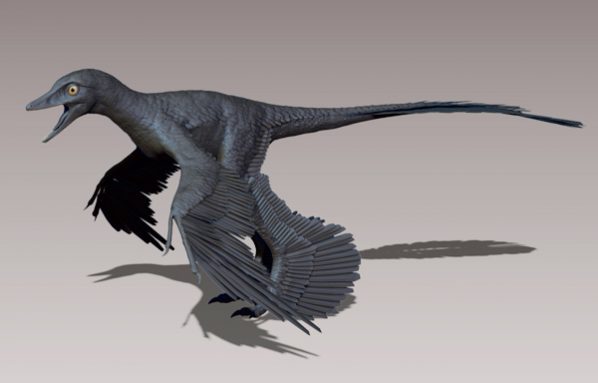Four-winged dinosaur
Hind wings helped a small dino make tight turns in midair
Share this:
- Share via email (Opens in new window) Email
- Click to share on Facebook (Opens in new window) Facebook
- Click to share on X (Opens in new window) X
- Click to share on Pinterest (Opens in new window) Pinterest
- Click to share on Reddit (Opens in new window) Reddit
- Share to Google Classroom (Opens in new window) Google Classroom
- Click to print (Opens in new window) Print

In a new study, scientists Justin Hall and Michael Habib and their collaborators suggest the dino tucked its hind wings under its body most of the time. It brought the extra wings out only when it needed to make tricky turns in midair. To make a right turn, the dino would lift its left hind wing, for example.
Hall and Habib, who work at the University of Southern California in Los Angeles, presented the new idea about these dinos at a recent meeting of scientists who research prehistoric animals.
Other scientists had suggested that the dinosaur glided through the air either with all four wings out or with one pair positioned beneath the other, like the wings on a biplane. Scientists are still arguing over whether the dinosaur could flap its wings and stay in the air like birds or just glide gently downward.
The new study suggests a simpler solution to the mysterious function of the four wings. Keeping the back wings tucked away most of the time would have made it easier for the animal to remain aloft, Hall finds. He notes that the feathers on the back legs were arranged in a shape that probably didn’t add much lift. Lift is an upward force that acts against gravity.
Keeping two wings hidden away when moving straight ahead would have made the dinosaur more aerodynamic, meaning it would have had a shape that let air flow past more freely. Extended all the time, the extra wings would have slowed the dino by creating resistance from the air. Air resistance, or drag, is the enemy of flight: A raindrop falls faster than a feather because air resistance doesn’t slow the drop down as much as the feather.
Hall and his collaborators studied the dinosaur Microraptor gui. It was the first found to have four wings. But it’s no longer the only one: Since M. gui’s discovery, other four-winged dinos have turned up. And their hind wings probably worked the same way, says dinosaur expert Luis Chiappe at the Natural History Museum of Los Angeles County.
Power Words
aerodynamic Having a shape that reduces resistance from air flowing past.
drag A slowing force exerted by air or other fluid surrounding a moving object.
lift An upward force that acts against gravity.
gravity The force that attracts any body with mass toward any other body with mass. The more mass there is, the more gravity there is.







